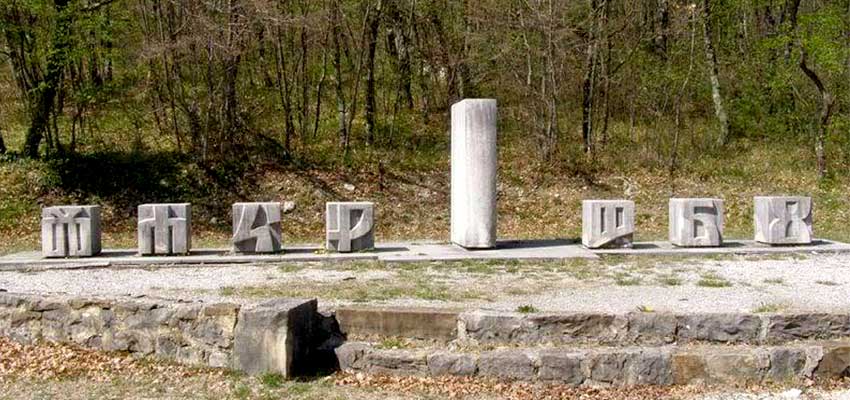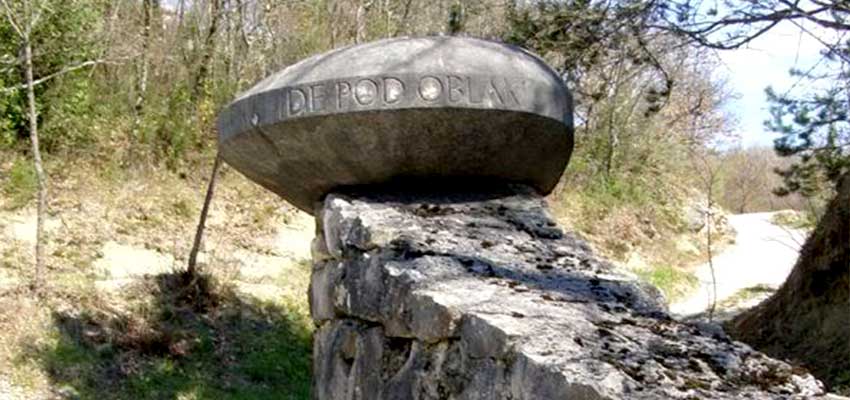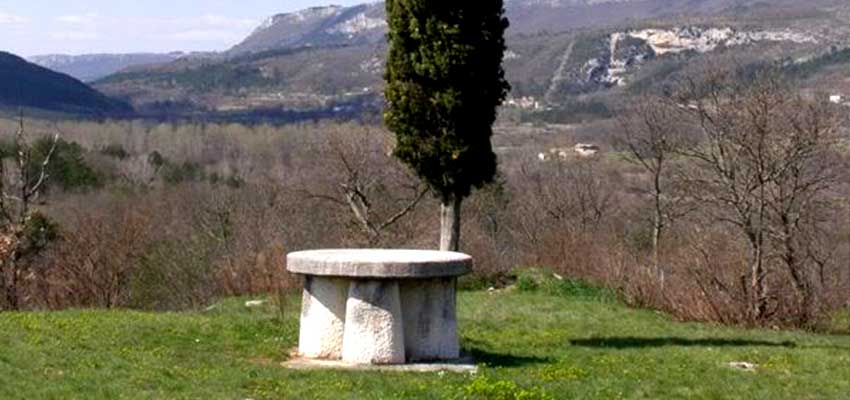A significant and exceptional monument complex commemorating Glagolitic heritage was erected in 1977 along the road from Roč to Hum. The Glagolitic Lane is a project of the Chakavian Parliament (Čakavski sabor). The author of the entire concept is Zvane Črnja, and it was realized through the work of prof. dr. Josip Bratulić and sculptor Želimir Janeš. The beginning of the Lane is at the foot of Roč hill with the first monument – Pillar of the Chakavian Parliament.
This monument in the form of the Glagolitic letter S symbolizes the first Slavic script and the beginnings of Slavic literacy. The remaining ten memorial sites are: Table of Cyril and Methodius, Chair of Kliment of Ohrid, Belvedere of Gregory of Nin, Glagolitic Lapidarium, Gorge of the Croatian Lucidar, Gradient of the Survey of Istrian Land Boundaries, Wall of Croatian Protestants and Heretics, Resting-area of Juri the Deacon, Monument of Resistance and Freedom and Hum Gates.
The glagolitic memorial-sites:
Pillar of the Chakavian Parliament – a memorial-site in the shape of the glagolitic letter S which symbolizes the first Slavic script and the beginnings of the Slavic literacy.
Table of Cyril and Methodius – the name of this stone table monument is written on the rim written in Latin, Cyrillic and Glagolitic. Two cypresses are planted beside to the table symbolizing the Holy Brothers.
The Chair of Kliment of Ohrid – dedicated to Kliment of Ohrid, the most meritorious disciple of Cyrill and Methodius the founder of the first Slavic university.
Glagolitic Lapidarium – a collection of copies of the oldest and most significant Glagolitic inscriptions fom Istra, the Kvarner islands and Dalmatia are built in the surrounding wall in front of the church in the village Bernobići.
Gorge of the Croatian Lucidar – dedicated to the Croatian Lucidar, the medieval encyclopedia used by our Glagolites.
Belvedere of Grgur of Nin – the Latin, Glagolitic and Cyrillic alphabets are inscribed on the stone block.
Gradient of the Survey of Istrian Land Boundaries – The Survey of Istrian Land Boundaries is a collection of documents from the 13th and 14th centuries about land boundaries of Istrian feudal lords: Aquilean Patriarchate, Pazin county and Venice. The memorial-site consists of stone blocks cut in the shape of Galgolitic letters which put together give the original name: Istarski razvod.
Wall of the Croatian Protestants and Heretics – in the centre of the stone wall, in the white stone block, the Galgolitic letter S is inscribed whereas in its upper part are names of famous Croatian protestants and heretics. Quotations from their works are inscribed in the seven stone slabs.
Resting-place of Juri the Deacon – dedicated to Juri the Deacon, an Istrian Galgolite who helped prepare the printing of the first Croatian printed book Missal from 1483. He enthusiastically announced it in Duke Novak's Missal (written in 1386) with words which are inscribed in the stone wall (in the shape of a book). The seven stone cubes resemble matrixes for hand typesetting while the letters on them spell: Žakn Juri (Juri the Deacon).
Monument to Resistance and Freedom – it consists of three stone blocks, one above the other. Each block symbolizes a particular historic period: the ancient world, the Middle Ages and the modern world. They symbolize the resistance of the people of Hum and its area against tyranny and banishment as well as their aspiration to peace and freedom throughout the ages.
Gate of Hum – made of copper hand-holds in the shape of ox's horns, the two door knockers bear welcome inscriptions. There is a peasant's calendar - twelve medallions with scenes of rural life – placed semi-circularly in the upper part of the gate.
(Text by Miroslav Sinčić)











